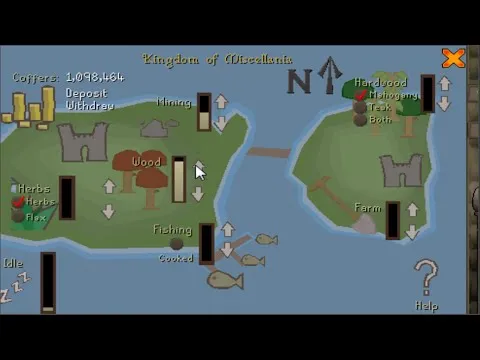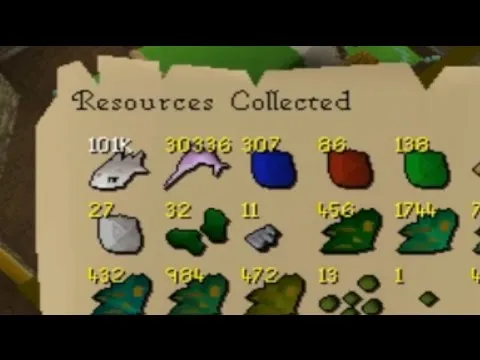Your cart is empty
OSRS Kingdom of Miscellania Profit Guide: Maximize Your Gains in 2025

Managing the Kingdom of Miscellania in Old School RuneScape (OSRS) is one of the most efficient ways to generate passive income with minimal effort. Whether you’re a seasoned player or a newcomer looking to boost your gold reserves, this repeatable activity—unlocked after completing the Throne of Miscellania quest—offers a steady stream of resources that can translate into significant profit. In this comprehensive guide, we’ll dive into how to optimize your Kingdom of Miscellania for maximum profit in 2025, covering setup, resource allocation, approval ratings, and more. Let’s explore how you can turn this island kingdom into your personal gold mine!
Before you can start raking in profits, it’s essential to grasp the mechanics of Managing Miscellania. This activity allows you to assign citizens of Miscellania (and Etceteria, after completing Royal Trouble) to gather resources like wood, herbs, fish, and coal. Your earnings depend on three key factors: your approval rating, the amount of gold in your coffers, and how you allocate your workers. With the right strategy, you can net over 100,000 GP per day—or more—making it a low-effort, high-reward endeavor.
Quest Requirements
To unlock Managing Miscellania, you must complete the Throne of Miscellania quest. For optimal profits, it’s highly recommended to also finish Royal Trouble, which increases your worker count from 10 to 15 and boosts resource output by 50%. These quests are relatively straightforward and well worth the investment of time for the long-term gains they unlock.
How It Works
Once the quests are done, you’ll manage your kingdom by speaking to Advisor Ghrim in Miscellania Castle. You deposit gold into the kingdom’s coffers, which pays your workers daily (up to 50,000 GP with Throne of Miscellania, or 75,000 GP with Royal Trouble). The resources they gather are based on your worker allocation at the time of collection, not during the gathering period. This flexibility allows you to adjust your strategy based on current Grand Exchange (GE) prices for maximum profit.
Setting Up Your Kingdom for Profit

Proper setup is the foundation of a profitable Kingdom of Miscellania. From maintaining approval ratings to funding your coffers, here’s how to get started.
Maintaining 100% Approval Rating
Your approval rating directly impacts how many resources your workers collect. It drops by 1% daily (post-Royal Trouble) or 2.5% (pre-Royal Trouble), so keeping it at 100% is ideal. The fastest way to boost approval is by raking weeds in the farming patches near the castle, requiring only a rake and level 10 Farming. This takes just a couple of minutes and ensures maximum output. Other options like chopping maple trees (45 Woodcutting) or fishing (40 Fishing) work too, but they’re slower.
Filling the Coffers
The coffers fund your workers’ salaries, deducted at 10% of the balance daily, capped at 75,000 GP after Royal Trouble. To maximize resources, keep at least 750,000 GP in the coffers at all times—enough for 10 days of full payments. For longer-term management, deposit up to 7,500,000 GP (the max post-Royal Trouble) to cover 100 days without needing to return. This passive approach is perfect if you’re busy with other OSRS activities.
Best Resource Allocations for Profit in 2025
The profitability of Miscellania depends heavily on GE prices, which fluctuate. However, certain resources consistently yield high returns due to their value or bonus items like bird nests and herb seeds. Here’s how to allocate your 15 workers (post-Royal Trouble) for the best results.
Mahogany Logs and Herbs: The Top Combo
Allocating 10 workers to mahogany logs and 5 to herbs is widely regarded as the most profitable setup in 2025. Mahogany logs fetch a decent price, and the hardwood option (unlocked after Royal Trouble) often outperforms other wood types. Herbs, meanwhile, provide a mix of grimy herbs (e.g., ranarr, avantoe) and occasional seeds, which can spike your profits. On average, this combo yields around 223 mahogany logs and 61 herbs daily, translating to roughly 150,000–200,000 GP profit after subtracting the 75,000 GP cost.
Alternative Options: Maple Logs and Coal
If mahogany prices dip, consider switching to maple logs (10 workers) and herbs (5 workers). Maple logs come with bird nests (1 per 100 logs), which contain valuable seeds and rings, often pushing profits above 100,000 GP daily. Coal (10 workers) with herbs (5 workers) is another solid choice, especially when coal prices rise, supplemented by occasional gems. Check the GE regularly to pivot your allocation based on market trends.
Pro Tip: Collect resources weekly rather than daily to save time. Adjust your worker allocation just before collecting to match the highest-profit options on that day.
Maximizing Efficiency and Passive Income
Managing Miscellania doesn’t have to be a daily chore. With a few tweaks, you can turn it into a truly passive income source while still optimizing profits.
Weekly Management Strategy
Instead of visiting daily, let your approval rating drop over a week (to around 93% post-Royal Trouble), then boost it back to 100% with a quick raking session before collecting. With 1,500,000 GP in the coffers, you’ll spend 525,000 GP over 7 days (75,000 GP/day) and can expect 1,500–2,000 mahogany logs, 400–500 herbs, and bonus items—often netting 1,000,000+ GP in profit. This method balances effort and reward effectively.
Travel Tips for Quick Access
Getting to Miscellania fast saves time. Use these methods:
- Ring of Wealth: Teleports you directly to Advisor Ghrim (requires charges).
- Fairy Ring (CIP): Drops you near the castle (unlocked via Fairy Tale II).
- Fremennik Sea Boots 4: Teleports to Rellekka, then a short boat ride (Elite Fremennik Diary).
The Ring of Wealth is the most convenient for frequent collectors, while the Fairy Ring suits those with quest progress.
Profit Breakdown and Long-Term Gains
Let’s crunch the numbers and see what you can expect from Managing Miscellania over time. The table below outlines daily output and profit for the mahogany/herbs setup, assuming 100% approval and Royal Trouble completed.
| Resource | Daily Output | Avg. GE Price (2025 Est.) | Daily Value |
|---|---|---|---|
| Mahogany Logs | 223 | 500 GP | 111,500 GP |
| Herbs (Mixed) | 61 | 1,000 GP (avg.) | 61,000 GP |
| Bonus (Seeds/Nests) | Variable | ~20,000 GP | 20,000 GP |
| Total Value | – | – | 192,500 GP |
| Cost (Coffers) | – | – | 75,000 GP |
| Net Profit | – | – | 117,500 GP |
Weekly Profit: 117,500 GP/day × 7 = 822,500 GP (assuming daily 100% approval). Over a month, that’s roughly 3,500,000 GP, and annually, you’re looking at 42,000,000 GP—all for a few minutes of weekly effort. For ironmen, the resources themselves (e.g., herbs for Herblore, logs for Construction) are invaluable, even without GE sales.
Factors Affecting Profit
Profit varies based on:
- GE Prices: Check prices daily or use tools like Alchmate’s Miscellania Calculator.
- Approval Rating: Lower ratings reduce output proportionally.
- Collection Frequency: Collecting less often increases total resources but requires more bank space.
Stay adaptable—shift allocations when prices spike or crash to keep profits high.
Long-Term Strategy for High-Level Players
For players with deeper pockets, deposit the full 7,500,000 GP and check in monthly. After 30 days without a visit, resource collection pauses, but with max coffers, you’ll gather for 100 days, yielding tens of millions in profit. Pair this with other passive methods like herb runs for a robust income stream.
Managing the Kingdom of Miscellania is a goldmine waiting to be tapped. With minimal setup—complete the quests, maintain approval, and allocate workers wisely—you’ll enjoy consistent profits in 2025. Whether you’re funding a bond, gearing up for raids, or stockpiling resources as an ironman, this method delivers. Start today, and let your kingdom work for you!
